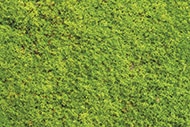Mosses are primitive green plants with tangled branching stems and small leaves that form mats on the soil under favorable conditions. They reproduce by wind-blown spores. These little plants, by themselves, are not harmful to the turfgrass, but mosses can form crusts over the soil and reduce the infiltration of air and water. They flourish in the shade, and in soils that are poorly drained, compacted, acidic and low in fertility. Any of these conditions, or a combination of them, will encourage the growth of moss.
If excessive amounts of shade are causing moss to grow, consider planting a shade-tolerant turfgrass. Tall fescue grass, St. Augustine grass, and some varieties of zoysia grass can grow in filtered shade. However, if the area receives less than six hours of the sun per day or is in deep shade, the site lacks the necessary amount of sunlight to grow healthy grass. As an alternative, consider mulching the area with pine straw, pine bark, or planting shade tolerant groundcovers such as liriope, mondo grass or Japanese pachysandra.
Moss thrives in areas with poor drainage and standing water. Incorporating organic matter to the soil to raise the elevation and to allow for better water infiltration will improve drainage. For larger areas that stay wet for prolonged periods of time, consider installing a French drain or drain tiles to remove the excess water. The application of excessive supplemental water can cause water to puddle and contribute to poor drainage. The rate and frequency of watering need to match the soil conditions, the water requirements of the turf, and the weather.
Poor soil fertility combined with a low pH weakens turfgrasses preventing them from competing with the encroaching moss. Consider having the soil tested through Gwinnett County Extension for pH and nutrient levels. Most lawn grasses prefer a soil pH of 6.0 to 6.5 except centipedegrass, which thrives in soils with a pH of 5.5 to 6.0. To raise the pH, add lime to the soil. If the soil lacks the necessary nutrients needed to grow healthy turfgrass, fertilize according to soil test recommendations. This does not kill the moss but will improve growing conditions for the turfgrass.
Compacted soils inhibit the infiltration of air and water, creating a favorable environment for the moss. Excessive foot traffic and lawn mower usage contribute to the problem. Turfgrass root systems suffer under these conditions. To find out if your soil is compacted, use a small shovel and try to dig down four inches in a section of the soil. If you have a hard time getting the shovel to penetrate into the ground, the soil is compacted. If the turfgrass roots in the sample are growing one inch or less below the soil’s surface, then corrective action needs to be taken. Healthy root systems should be growing at a depth of four to six inches. To remedy the problem, use a hollow tine aerator or a steel rake to break up the compacted layer of soil to enhance drainage and air exchange.
Moss can be eliminated by the application of chemicals labeled for controlling it. As the moss begins to die, it will turn an orange-brown color. After dying, remove the dead moss by raking. Though moss can be controlled by chemical or mechanical means, it will return if the cultural conditions that favor the growth of healthy grass are not implemented. Otherwise, the grass will continue to die out, and the moss will prosper.
Timothy Daly, is an Agricultural and Natural Resource Extension Agent with Gwinnett County. He can be contacted at 678-377-4010 or tdaly@uga.edu


